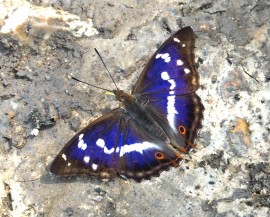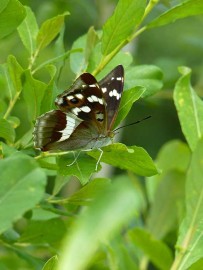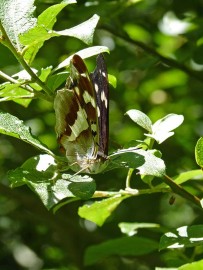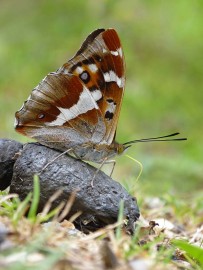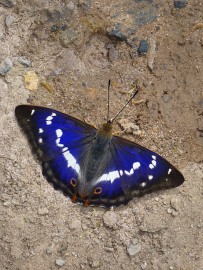by Martin Kalaher
The Purple Emperor is the largest of our woodland butterflies and away from well-known Sussex hotspots remains an elusive species which is not that easy to find. Only the male is purple, but the light conditions and the angle of the sun must be just right for the exotic colours to be fully appreciated and in dull light it may appear black or dark brown. The female is larger than the male and is a rich, dark brown. For those not very familiar with this species a high-flying White Admiral could cause confusion. However, the latter is much smaller and has rounded, not pointed wings and has a different flight profile, which is generally described as 'graceful and flitting'. The larger, more powerful Purple Emperor habitually glides for appreciably longer periods, the gliding flight sustained with short flicks of the wings.
The present-day flight period compared to 20-25 years has moved forward by two weeks or more. A typical first-appearance date is between June 20th -25th, with most adults then emerging over a three-week period. The flight period is reasonably short and by early August the adult butterfly season is over. Colonies are generally small and often scattered over many neighbouring woods and copses. As with some other species that hatch in low densities over a wide area they overcome the potential problem of the sexes finding each other by using leks. These are usually located at a high point within the complex of woods, with the so-called 'Master Tree' usually consisting of a small group of Oaks; although in Sussex other tree species such as Ash, Beech and Scots Pine are also used. The males adopt other strategies when searching for a mate which includes 'Sallow-searching', during which they constantly patrol the Sallow nursery areas at canopy height, actively searching out any freshly-emerged female.
Once mated the females look for suitable sallows on which to lay their eggs. Goat Willow is preferred but Grey Willow and various hybrids are used. Easy accessibility is required, as is a degree of shade. Sallows abutting woodland rides and glades are frequently used and the eggs laid singly, and well-spaced on the upperside of a shaded leaf, near the crown of the tree. The caterpillar is extremely well-camouflaged after its first moult, after which a slightly bizarre-looking pair of horns appear. By early November it undergoes a second skin change and shortly afterwards leaves its feeding leaf, locating a crotch of a forked branch where it spins a pad of silk and then hibernates for the winter. It resumes feeding in the spring and after undergoing its final moult crawls away from its feeding leaf and attaches itself to the undersurface of another leaf where it develops into a well-camouflaged chrysalis.
This beautiful butterfly is widespread throughout West Sussex and can be found in the west and the north of East Sussex. If one compares the distribution maps of the 1990-1994 Sussex butterfly survey with the more recent 2010-2014 survey it is evident that this species is gradually colonising East Sussex from the west and north. Until very recently Sussex butterfly enthusiasts flocked to the Southwater Woods complex of woods to observe and photograph Purple Emperors but now its premier position has been usurped by the rise and rise of the Knepp Estate. In a single day on 11 July 2015 an amazing 126 individuals were counted, which secured this location as the best site in the UK for this species!
A short summary cannot do justice to this beautiful insect and if you haven't already done so I would urge you to read a very detailed and entertaining account by Neil Hulme, in 'The Butterflies of Sussex'.
Where to watch the Purple Emperor: Knepp Castle Estate TQ134193 to TQ14121; Southwater Woods TQ131257 to TQ140254; Eartham Wood to Bignor Hill SU940105 to SU970128; Houghton Forest SU997105 to SU995112; West Grinstead Downs Link TQ183225 to TQ173245.



